In perusing our backyard, I have lately become aware of the need for a new plant taxon, and, since I seem to be alone in this so far, I have taken the liberty of naming it. I call it Family Dangerfieldaceae. (I suspect that this taxon may eventually be elevated to a higher level—-maybe as far as Kingdom Dangerfieldae—-but we’ll start here for now.) This new family is not based on morphology or habitat or even genetics, although all of these may play a role in its members’ classification. It is based rather on the quality of getting no respect.
My first nomination for this new taxa is Late Boneset (Eupatorium serotinum) also known as Late Flowering Boneset, Late Flowering Thoroughwort, and White Boneset, among other names.
Take this description, for example, “Eupatorium serotinum is among the weediest species of Missouri thoroughworts, with little fidelity to any particular habitat, moisture regime, or substrate type.” You see? It’s not only “weedy”, but it’s unfaithful to pretty much any place or thing. If it got respect, it would be referred to as “aggressive” and “adapted to a wide variety of habitats”.
Or this one, “Interesting Info: Slender, serrated leaf distinguishes this plant from the more interesting true boneset.” This plant is uninteresting and untrue, at least compared to E. perfoliatum. Yawn.
This member (so far) of the Aster Family has more going for it than that, in my opinion. It is a showy (kind of) perennial wildflower, growing up to 4-5 feet tall, blooming in late summer and into the fall, branching well up on the stem into numerous panicles with small white flowers.
It is found from Nebraska south to Texas and pretty much everywhere east, including a possible population in Ontario. It is said to prefer moist areas, which seems to be true in our yard, but can tolerate some drought, although some lower leaves may brown and drop off. It sailed right through the hot, dry summer this year and seems to require no maintenance that we have discovered. It doesn’t show much tendency to take over and pretty much minds its manners. It likes to be around the water feature in our backyard, but it’s not addicted to it.
Maybe that’s why it tends to be overlooked. No squeaky wheel, this. It doesn’t seem to have any special medicinal properties or fascinating folklore. It doesn’t appear to be much celebrated in song, poetry, and legend. All that is reserved for its close relative, Common Boneset (Eupatorium perfoliatum), which can treat flu, dengue fever (breakbone fever, get it?), worms, malaria, diarrhea, and who knows what else? Back in the day it made kids run hard to avoid being dosed with its bitter, smelly tea for whatever ailed them. Wiccans even use it to conjure Banishing Spells to avoid unpleasant people.
But I digress. We don’t have Common Boneset in our backyard. We have Late Boneset, which wouldn’t be caught dead attracting such attention.
So why do I think this plant deserves more respect? Stand beside it on a nice late summer or early fall day and watch the party. Bees, small and large, wasps, and butterflies find it irresistible.
Like Partridge Pea, if you look out of the corner of your eye, it sometimes looks as if the plants are moving, there are so many insects feeding on the flowers. If you want to attract pollinators to your surroundings Late Boneset is a standout. Now also consider the time of year that it reaches its full bloom. It coincides with the migration of the mighty Monarch Butterfly, and this unassuming
perennial appears to provide a significant source of late-season nectar for the long journey south. Keep your Banishing Spells—long live the Monarch!
Plus, in the right company Late Boneset is hardly a wallflower. Its white inflorescences, not very ornate by themselves, can join up with other late-bloomers for some memorably beautiful combinations. Consider it for use as a cut plant and in dried plant arrangements.
So give our shy lady a little bit of respect. She doesn’t ask for much and gives a lot.

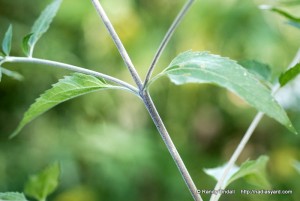
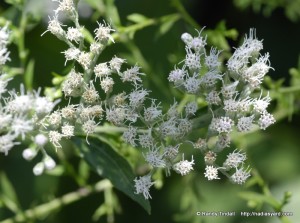
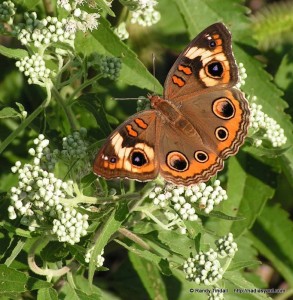
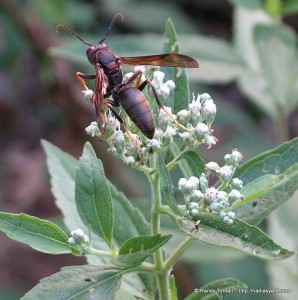
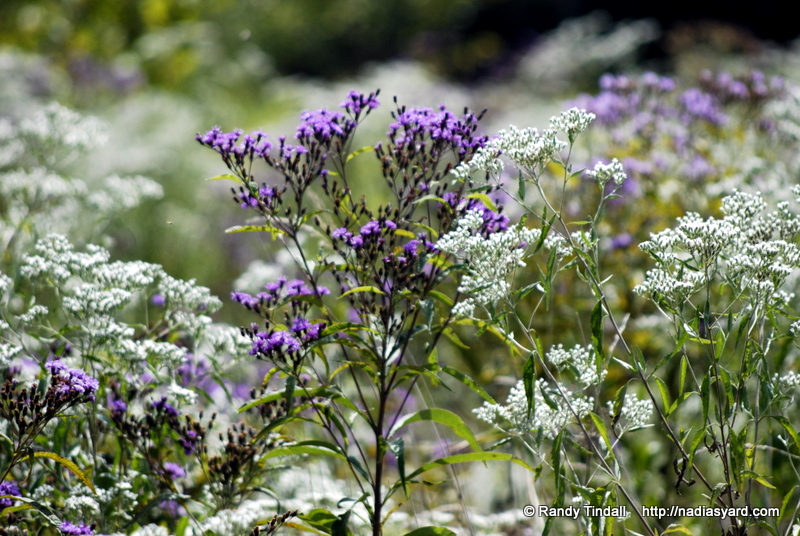
This plant was very respected by the late herbalist Tommy Bass, who used it for prostate gland trouble and diabetes. It is truly a wonderful plant!
This was Bass’s Queen of the Meadow.
Thanks for the comment, Debbie. I will look into Tommy Bass and his work.
Bass was talking about eupatorium perfoliatum and not late boneset <3
Lauren, I need to correct this statement for anyone looking for a reference in the future.
Bass used Eupatorium serotinum frequently in his clinical practice like Debbie said. It is specifically stated in “The Book of Herbal Wisdom” by Mathew Wood. However, he does say it is milder than Gravel root but with similar properties.
Thanks.
Thanks so much for the clever and most entertaining information about the late boneset native plant. I had searched the internet to identify a very large bush with late blooms, that I had no recollection of planting, and had found what it was. That did
not satisfy,but your contribution to it’s fan club was just what I was looking for!
Thanks for reading, Danielle. This is a great plant if you want to encourage pollinators on your property.
Thank you for this article! I’ve been trying to figure out what this beautiful green plant was in my new backyard since spring! When it first popped out of the ground, I was fascinated by how green the foliage was…so instead of running it down with the lawn mower, I decided to let it grow. And grow it did! It’s nearly 6 feet tall now, and it just bloomed today. What amazed me most is that it’s completely covered with pollinating insects of all kinds!!! I think it definitely deserves notice in the quiet way it spoke as I approached with the blade to let it live! Something that puts so much effort to grow tall and strong in a season..and yet feels no need to boast is something that definitely deserves our respect!
Thanks, Jesse. Very glad you enjoyed the article. Your pollinating insect buddies will thank you for saving that plant. It’s a favorite of theirs!
We planted several new butterfly/hummingbird/bee attracting perennials this spring. They were small and although they are surviving, have not done much of interest this year. Waiting for next year to enjoy. Then, suddenly appeared several rather large plants mixed in amongst the ironweed, etc. I left them alone, fearing I might be removing something I just planted but was not familiar with. This week they broke into lovely white blooms. And I found a great description here. Thanks. I have Late-flowering Boneset. My only fear is that they seem so vigorous they may choke out the smaller plants before they get established. Trying to decide if we should thin these back.
We have never noticed that this is a very aggressive species, at least in our yard. It seems not to spread or choke out surrounding vegetation here, but that doesn’t mean it might not be aggressive in other environments. Let us know how it goes with your plants.
Thanks for commenting! Keep us posted.
Wonderful post! Just identified this plant in the yard of the house we recently moved into. I love native plants and hold dear all the “weeds” that others are quick to pull and mow down. Now I can welcome late boneset to the family.
Hang onto those “weeds”!! Especially your Boneset. Your pollinators will thank you! Our wilderness has so far survived the yard police, so there is hope.
Thanks for commenting and reading.
I live in western Fairfax Co, Va and have found an abundance of late blooming Boneset (Eupatorium serotinum) in the wet areas near Cub Run and its tributary Flatlick Branch near where I live, where Tickweed sunflower, Ironweed , Blue Mistflower, Late blooming Goldenrod and Wingstem are also prevalent in late summer and early fall. I’ve found just two areas where true Boneset (Eupatorium perfoliatum) grew in the same areas but with just a few plants. Does anyone have comments about the incidence of True boneset vs. late Boneset, especially in the Piedmont area of Virginia?
I’ll be curious to see what people have to say about this. Thanks for commenting.
I have been reading about a few fall blooming plants (Common Boneset, New York Ironweed) when I ran across your article on Late Boneset. We were planning on planting Boneset and Ironweed not only to help out the pollinators, but to help fuel up the late season Monarchs before they grab their sombrero’s and head south for the winter.
Although not easy to find, I have been able to find a few native nurseries around us that carry Common Boneset. However, no one seems to carry Late Boneset. Is there a big difference in bloom time between Common Boneset and Late Boneset? Since our main goal is to help the Monarchs, should I settle for Common Boneset, or should I keep searching for Late Boneset. Thanks for any help you can give me on this.
Brian, I passed this one on to Nadia, who is a real, honest-to-god botanist. According to her, Common Boneset will do about as well as Late Boneset for you, with similar blooming periods. Regarding finding plants, these are so common in the wild that you are unlikely to find them in nurseries for sale, but here is a source for seed: https://www.prairiemoon.com/seeds/wildflowers-forbs/eupatorium-serotinum-late-boneset.html. You could probably also find seed on mature plants growing wild. You didn’t say where you are from, but you can probably search for “late boneset seed sources” and find someplace local. Thanks for reading and commenting (and for helping out the Monarchs)! Let us know how it works out. Randy
Very aggressive plant around Newburg, MO. It is trying to take over my pasture so I am trying to find a way to get rid of it without chemicals. Any suggestions. Also, I don’t get many Monarchs or honeybees here. My goats won’t eat this plant. As aggressive as it is I don’t see a reason to save it.
Hi Annette. If the boneset is really causing you problems, I guess I would contact your county extension office for control suggestions. It can indeed, be assertive, but it is very well behaved in our yard. Regarding reasons to keep it, it is attractive to lots of butterflies, especially small ones, other than Monarchs and it is really popular with many native bee species, besides the introduced honeybee, as well as many other good insect species. I’m guessing that mowing and/or burning might be possible control methods. For us, herbicides are the very, very last resort, but sometimes, as in the case of Sericea lespedeza, for example, it may be your only choice. Check your extension agent first, though. Thanks for reading!
“Stem and Alternate Leaves of Unfaithful Late Boneset”
Oops, those leaves are clearly opposite — Typos happen. 🙂
Thank you, James! I ALWAYS welcome these corrections! Corrections have been made. I also discovered a picture of a “buttlerfly”. Must have been watching “Downton Abbey” round ’bout that time.
For Annette, if this species is indeed becoming pesty as it can early in a prairie restoration, Bill Davit gave us this advice. Once the lower leaves start dropping off, mowing really hurts them. Hopefully you can leave some in fence rows or other out of the way places to help the pollinators.
Thanks, Ann! Good information!
I couldn’t agree more about this plant, although here in southeastern Pennsylvania and certainly on my wooded acreage it has proliferated, this year more widespread than ever previously such that I’ve had to yank it out from flower beds — and it roots itself fairly well which poses a challenge and requires a good, solid grip.
I’ve definitely used it in flower arrangements, as the white blossoms have a very sweet fragrance.
Thanks for the comment. Look below in the other comments for one suggestion for controlling this plant, if it gets to be too much. Cheers.
Everglades National Park ~ Late Boneset (Eupatorium serotinum) not one of the most dashing of our wildflowers, but certainly a fine addition to the verges of borrow pits, canals, trails. Attracts butterflies, beetles, bumblebees, bees, & other bugs galore. Also, a cousin plant, but with far more aromatic leaves, is Jack-in-the-Bush (Eupatorium odorata) is also an attractor of pollinators.
Thanks for reading and commenting! I’ll check to see if we have E. odorata here.
There was a comment above about Late Flowering Boneset also being called Queen of the Meadow which made me excited and I started digging. It seems there is a difference between Late Flowering Boneset (Eupatorium serotinum) and Queen of the Meadow (Eupatorium purpureum). Late Flowering Boneset is useful in many ways visually and to insects, but sadly I can not find much of anything about medicinal uses. Darryl Patton (trained by Tommy Bass) helped me ID a plant I have as Late Flowering Boneset so I am pretty sure they can not be the same thing.
Interesting about Queen of the Meadow. Thanks for commenting on this. And, yes, Late Flowering Boneset is the wallflower of the family, it seems, with regards to medical and other uses, but pollinators looovvve this plant.
I met Darryl Patton in 2021 at a homesteading conference and a year later tried to contact him with no success. Anyone know how he is? I am enjoying this post and comments by informed folks very much. I realize it’s been a decade or more. I have many Late Boneset bushes blooming now, and have much more respect for it now. After 4 years on this place in Tennessee, I have only seen a handful of Monarchs and once in April and the other times in October on an Aster. After following the Western Migration in 2016 (video on my YouTube channel) and raising Monarchs in CA, I sorely miss seeing them here. I will keep all of my Late Boneset through fall in hopes of attracting them. Meanwhile, I am disappointed I don’t have Common Boneset for its medicinal properties. Since the only difference seems to be size, and the leaves are bitter, I wonder why it wouldn’t also encourage sweating? Hope to hear, and hope the site is still being serviced. Much appreciation.
I have a 22 acre CRP field that is wall to wall with Late Boneset. All of it is about 6 ft and taller. It is very fragrant.
Lucky you! I wish we had 22 acres! I bet if you go and check, those plants will be teeming with pollinators, especially small native bees. Thanks for reading.
I finally found someone who described one of this plant species outstanding qualities…FRAGRANCE! I didn’t think I’d find anyone pointing this out. Good for you Kris K. n thanks……That’s probably one of THE attractants to this species overall……I have a huge plant of this out front at my rural driveway ent. and it’s in full flower now, loaded with all kind of pollinators especially Bombus!! I loathe most Eupatoriums, but not this one!!! The fragrance is light n delicate as the plant should be treated as well!
John
Wonderful to know. I have many bushes on my rural place. Have not smelled it, but I will today! Why do you loathe most Eupatoriums? Thanks for replying. Much respect.
This IS my plant!!! The only way I knew for sure was an app called Picture This. I’ve been to the best local garden store and kept being told it was milkweed. Well without sap and smell, I knew it was not milkweed. The app was right!
Congrats! Boneset finally got some respect! Thanks!
I ID’d from PictureThis as well!
I followed my nose to the pasture fence today and discovered our Late Boneset. I’ve been all afternoon trying to ID it. So glad I found you and thank you for this post. Wish I had a way to post photos. I got some really detailed ones.
More respect for E.serotinum ……I may have missed it but so far I’ve not seen anyone mention that this plant has a delicate but wonderful fragrance…..if you can’t ‘catch it’ from the flower clusters, stand down wind for a large flowering specimen…..you should be able to appreciate it! I’m in cent. Va. btw. midway between F-burg n Richmond.
I have this plant growing front and center in my front yard. I’m worried it will take over like pink primrose (onethera) and I will be battling roots etc. Should I move it to the back? It’s in full sun
I don’t know about your specific circumstances, but our Eupatoriums have never been aggressive and crowded out other plants. I would just watch and see. Thanks for reading!
I am pretty sure this is the strange plant that came up in the middle of my bed of milkweed this spring. It appeared before the milkweed was pushing up, and i left it alone to see what it might be. It grew. And grew. And grew. At six feet, i still was unable to determine what it was. Only when the flowers began forming a couple of weeks ago did i get some hits on plant ID apps.
The stalks from this one cluster are 6-7 feet tall. It is overshadowing the rest of this bed of much shorter plants.
I would love to keep this native in my yard, but not where it is currently. If i cut this back in fall, dig up the rootball at the base, and move it to another location, will it come back as a perrenial from the rootball?
This sounds a little strange to me, both in timing and size. I would have somebody who knows check this out before I did anything. There is a new poisonous plant out there called Giant Hogweed that grows very tall and is VERY nasty. I hope that’s not what you have, but check it out online.
https://www.goodhousekeeping.com/home/gardening/a21598753/giant-hogweed/
Jim – I currently have exactly same situation you had 3 years ago: unknown plant that I would now ID as late boneset, way too big for current location – this cluster is also about 7 feet tall and in the middle of a bed of much smaller plants. It looks a bit absurd at this time, really, which doesn’t bother me for one growing season but I’d like to put it somewhere more appropriate for next year. I am wondering: Did you cut and move it in fall? Did it survive the relocation? (Randy – I followed your link suggestion and this plant is definitely not Giant Hogweed)
I first found this plant growing in my yard last year. I have an only semi-tamed front yard of mostly flowers and herbs, and my backyard is mostly vegetables, with some random flowers. I hadn’t even noticed it at first because last year I was constantly behind in my garden maintenance and the corner it was growing in was neglected all summer. Suddenly, I notice this very tall plant with white flowers covered in insects of all kinds. Truly amazing! Bees, wasps, butterflies, oh my! I even filmed a praying mantis catching and eating a butterfly. However, I was so busy last year, that I let it go without trying to identify it, hoping it would seed itself. It did, and I finally know what it is! Thanks for your most complete description and information. I plan on saving its seeds and planting more clusters next year. Do you have any information on seed propagation? Thanks, Julie
Thank you for reading and preserving this plant!
Can I use Late Boneset in tea or does it have other uses?
When I moved from a farm in Ste. Genevieve County to Columbia MO to set up what pollinator friendly garden I could here, I found a nice, tall plant in my old yard and decided on a whim to move it. It grew taller (well, 5 feet is tall to me!) but didn’t bloom until recently. I asked a friend to help me differentiate it from White Snakeroot, which she did, and I’m glad to say that I have tons of respect for Late Boneset. It has been feeding pollinators very well, thank you very much, is quietly beautiful, and a very happy accident in my tiny garden. So if people think I’m nutty for transplanting something I couldn’t identify into my herb and pollinator garden, well, what’s respect anyway? I’d rather have a happy accident any day of the week.
One thing that should be noted is that it does have look alike that is POISONOUS. White snake root. Years ago we had late thoroughwort sprout in our rock garden. I couldn’t find much information on it but was able to find its poisonous look alike that I could compare it too. I was then positive in my assessment of it being late thoroughwort. We now dry it and use it in our simmer pot to help loosen phlegm in the lungs. The floral smell is wonderful and have been debating about getting a stove top distiller to try to extract the plant oils to make a perfume.